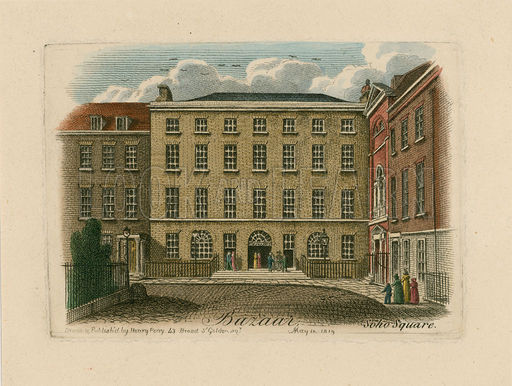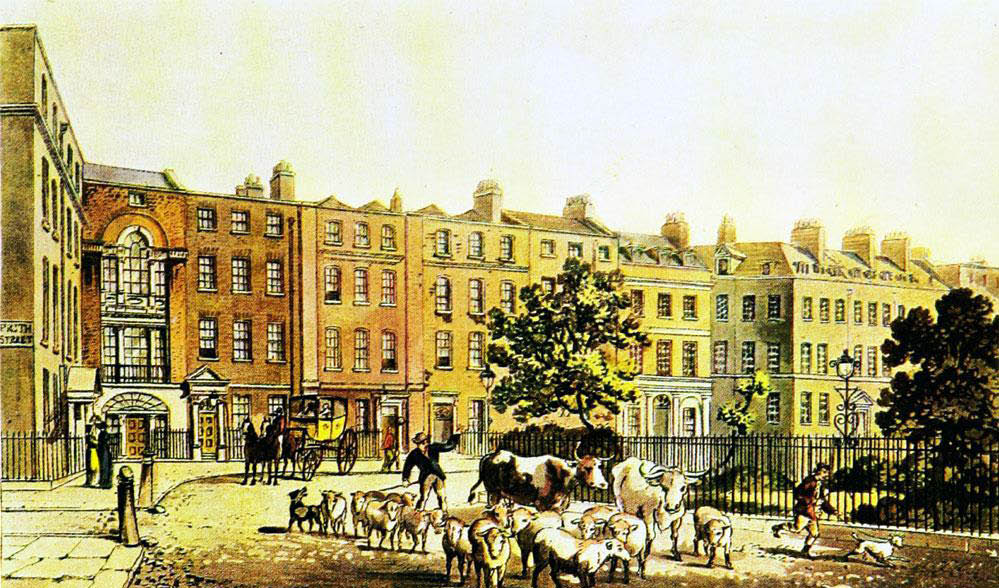
As late as 1839, Soho Square was described in History of London as presenting “a very pleasing and somewhat rural appearance”. Dating back to the 1680s, it has a park and garden area in the center complete with a statue of Charles II. (here is a link to another post on the statue in the square: https://regrom.com/2016/11/18/regency-hot-spots-soho-square)

From the beginning, Soho was one of the most fashionable places in London to live, and in its earlier decades Soho attracted notable residents. By the 1800s, it was home to a variety of booksellers, artists, and assorted businesses, including the last days of the brothel the White House (side note, this brothel had a gothic “Skeleton Room”, among other themed rooms, where a mechanized human skeleton popped out to scare patrons…you bet I am going to be writing an upcoming post about this!)
The most interesting thing about Soho Square during the Regency was the Soho Bazaar, a closed market established at the end of the Napoleonic Wars for widows and daughters of army officers to rent cheap stalls and sell handicraft (Cholera, Chloroform, and the Science of Medicine: A Life of John Snow, 2003). Opened in 1816 by Mr. John Trotter to “encourage female and domestic industry,” it opened to the public on February 1st of 1816, and was reported to receive an average number of 2,500 daily visitors (Soho and Its Associations: Historical, Literary & Artistic, 1895). It was evidently so popular among “persons of consequence and position…that the adjacent portions of Soho Square were occupied by two or three rows of waiting carriages,” (Soho and Its Associations: Historical, Literary & Artistic, 1895, p. 178).
Essentially, Trotter created a cooperative market for widows, orphans and dependent relatives who had lost men in foreign service and were unemployment, distressed, and needed a help. Trotter had a large amount of property and offered them to the government for this purpose, which they refused. He then undertook the establishment of the market himself (Soho and Its Associations: Historical, Literary & Artistic, 1895).
At its height, Soho Square Bazaar had as many as two hundred sellers (Two Centuries of Soho: Its Institutions, Firms, and Amusements, 1898) offering “light goods” and a “fashionable lounge” (Leigh’s New Picture of London, 1830). According to Cruchley’s Picture of London, the Soho Square Bazaar was “a very fashionable resort for ladies of distinction” wishing to make purchases of any number of “light purchases” including “every article pertaining to female dress or ornament, toys, jewellery, perfurmery, cutlery, literature and the arts” (Cruchley’s Picture of London, 1834, p. 123).
A sort of children’s book was published in 1818 called “A Visit to the Bazaar” which features an adventure through the shops and a series of lovely pictures depicting different stalls. You can click on any of the pictures to see an enlarged version for more details:
Here is the outline circulated to press and others about the Bazaar:
New Monthly Magazine, Volume 5, 1816
The market was in No. 4, 5 and 6 in Soho Square. Here is a lengthy, but interesting description:
(Soho and Its Associations: Historical, Literary & Artistic, 1895).










